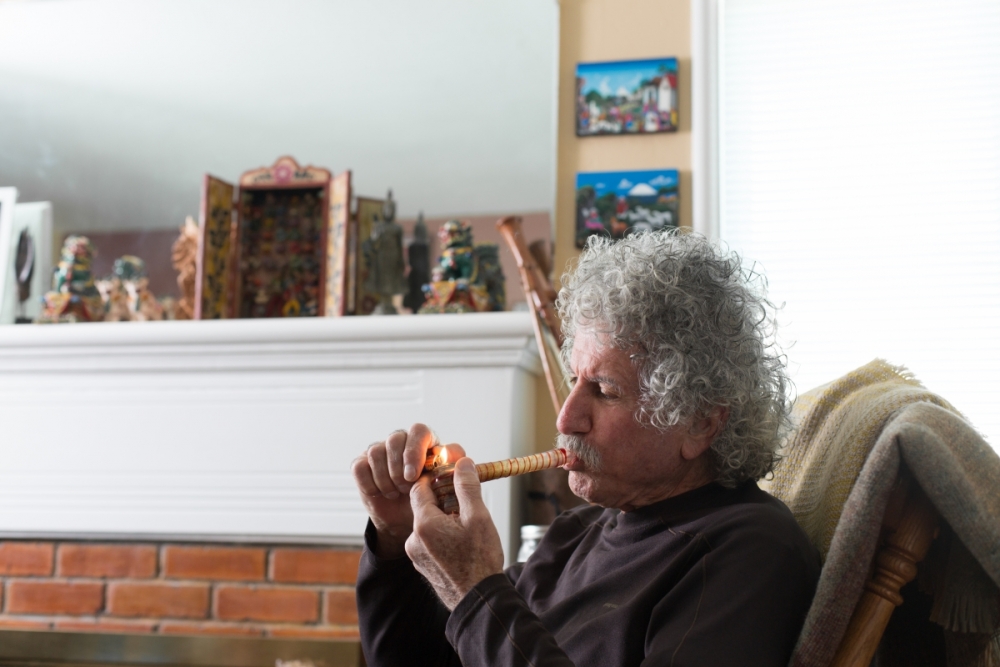Science & Health
‘Lazy Stoner’ Stereotype Smashed By Study Finding Marijuana Consumers Exercise More

Does marijuana ruin an exercise routine? You might be surprised. A new study of older Americans found that cannabis consumers tended to do more formal exercise and engage in more physical activities than non-consumers during the course of a four-month trial.
While authors cautioned the findings are preliminary, they contribute to a growing body of evidence challenging the lazy-stoner stereotype.
“Compared to older adult nonusers,” says the study, out of the University of Colorado at Boulder, “older adult cannabis users had lower [body mass index] at the beginning of an exercise intervention study, engaged in more weekly exercise days during the intervention, and were engaging in more exercise-related activities at the conclusion of the intervention.”
In other words, not only were adults over 60 who used marijuana generally in better shape than their peers who abstained from cannabis, they were also more responsive to an assigned four-month “exercise intervention trial”—essentially a regimen of physical activity prescribed by a clinician.
“These findings suggest that it may be easier for older adults who endorse using cannabis to increase and maintain their exercise behavior, potentially because cannabis users have lower body weight than their non-using peers,” wrote the study’s authors, a team at CU’s Department of Neuroscience and Psychology. “At minimum, the evidence suggests that cannabis use does not hinder older adults’ ability to engage in physical activity, to participate in a supervised exercise program, or to increase their fitness as a result of physical activity.”
“In this study, current cannabis use was associated with lower BMI and more exercise behavior in healthy older adults wishing to increase their physical activity.”
Researchers said the analysis, published this month, is especially important because more and more older Americans are consuming marijuana for medical or personal use. “Adults over the age of 50,” the study notes, “are the fastest-growing population of cannabis consumers in the US, with national prevalence rates estimated at up to 9.1% in 2013.” Of that group, people 65 and older showed even greater increases in use.
While those numbers may be several years old, the trend of rising marijuana use among older adults has continued.
“We haven’t seen a big spike in consumption” across most age groups, then-Colorado Gov. John Hickenlooper (D) told Rolling Stone in 2018. “The only increase in consumption is among senior citizens, which we think is either Baby Boomers coming home to roost or arthritis and the aches and pains of growing older—people finding that marijuana is better pain solution than opioids or other things.”
Yet with so many older Americans failing to meet recommended daily activity levels, the researchers in the new study wanted to better understand how cannabis might affect exercise routines.
“Given the plethora of negative health consequences associated with inactivity and the protective factors associated with exercise,” they wrote, “efforts must be made to understand factors, like cannabis use, that may affect older adults’ engagement in exercise.”
The study looked at American adults age 60 and older who researchers classified as sedentary, defined as completing less than 80 minutes of moderate physical activity per week. Some were assigned to a training program of moderate physical activity, while others were put in a program with low-intensity exercises. A total of 164 participants completed the study through the eight-week checkpoint, with 153 making it through the 16-week timepoint.
Researchers measured participants’ body mass index (BMI) and other health parameters at the beginning, midpoint and end of the study period. Participants also self-reported their exercise behavior in journals. All participants’ exercise programs included supervised training at the research facility three days per week, the paper notes. “Thus, we would expect both groups to be exercising a minimum of 3 days per week.”
“These preliminary data suggest that current cannabis use status is not associated with a negative impact on fitness and efforts to increase exercise in sedentary older adults.”
Researchers admit they’re not entirely sure why cannabis use is associated with lower BMI scores or why people who consumed marijuana were better at sticking to their workout schedules. “Future work,” the paper says, “should employ methods that allow for a target exploration of the mechanisms by which cannabis might be associated with exercise, be it via lower body weight, increased enjoyment, decreased pain, or faster recovery.” All of those potential factors, the team noted, have been hinted at by existing research.
A separate study out of the University of Colorado published last year found that a majority of marijuana consumers reported that cannabis use before or after exercising improves the experience and aids recovery.
The new study highlights an association between cannabis use and exercise, but it leaves many questions unanswered. Researchers didn’t ask participants, for example, about whether they used marijuana before, during or after their exercise. And the study’s measure of cannabis use, the authors wrote, “was coarse and lacked detail,” such as how often and how much marijuana each participant consumed.
“We did not query what form of administration (ie, smoked, vaporized, edible, topical) or cannabinoid content (ie, THC and/or CBD potency) was used,” the study says. “We also did not query whether users’ perceptions of any relationship between cannabis use and exercise, such as increased enjoyment of and/or recovery from exercise, or decreased perceptions of pain, might be driving the association between cannabis group membership and exercise.”
Nor did the researchers ask participants about any negative side-effects of their marijuana use.
Limitations aside, the researchers argue that their findings should encourage further research into how marijuana and exercise might coexist. “It may be that different types of exercise, such as those that that require minimal fine motor coordination or present low injury risk, might be most positively associated with cannabis use,” they write.
Perhaps most optimistically, the authors suggest cannabis could even be used to encourage older adults to stay active. “Whereas the results are preliminary,” the study says, “with both more extensive and rigorous additional research needed, the discovery of a role for cannabis as a potential facilitator of physical activity among older adults may hold promise.”
The paper begins on page 420 of the July edition of the American Journal on Health Behavior.
Study Finds Marijuana Motivates People To Exercise, Smashing Lazy Stoner Stereotype
Photo courtesy of the Drug Policy Alliance, Sonya Yruel.




